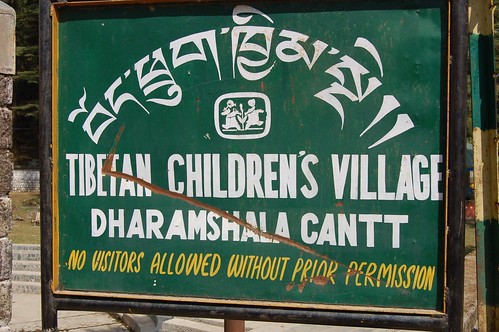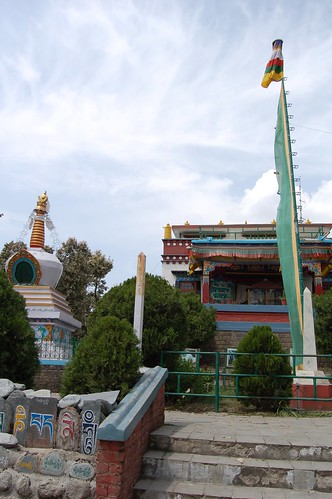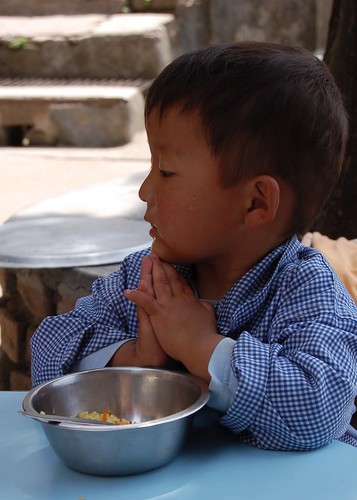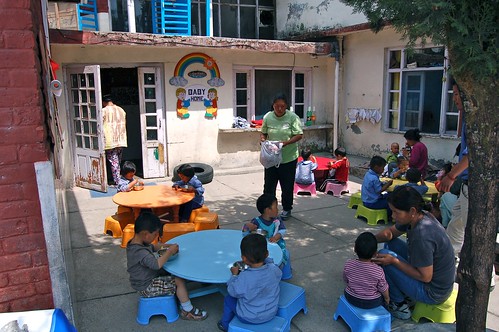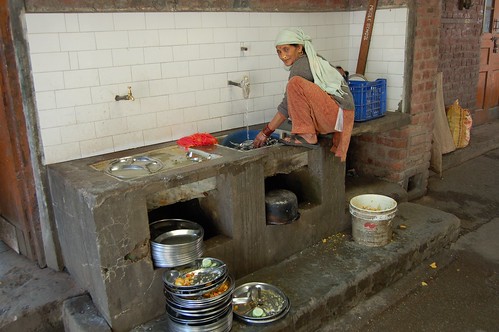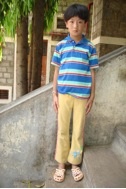In 2012, I visited the Tibetan Children’s Village in Dharamsala and felt compelled to sponsor a student. We were assigned a little girl named Tenzin Nordon, who lives at another TCV campus in southern India.
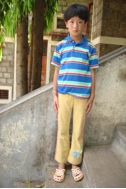
Tenzin writes to us a few times a year, enclosing cute drawings and notes written in marker. Her letters used to start with “Dear Sponsor,” but lately she’s switched to “Dear Godmother,” which feels more than a bit misguided.
Tony and I talked for a year about visiting Tenzin, so we finally scheduled a long weekend get-away to Bylakuppe, home to thousands of exiled Tibetans in the Indian state of Karnataka. Our trip was scheduled for mid-May. We shopped for gifts, picking up a rubik’s cube, a couple board games, an art project and some clothes. Tony was remarkably savvy at shopping for a 12-year-old girl.
Unfortunately, I was sent to Washington D.C. that weekend to sort out my Indian work visa, so Tony had to make the trip alone. I’ll let Tony tell the story.
Me: Describe the journey.
Tony: We landed in Bangalore and a driver met me for a 7-hour ride to Kushalnagar (the nearest town to the TCV school). When I landed, I felt like I was in the desert. I looked around and things were pretty darn barren. The air was cleaner than in Delhi, but there was a quietness, a lifelessness. But by the time we got to Kushalnagar, I have never in life seen such fertile land.
There were fruit stands everywhere. There was no poverty like you see in Delhi. It seemed everyone had food and everyone was being used productively; everyone had a job. There were truckloads of mangoes everywhere, and everywhere you looked there were giant coffee plantations and bananas growing. Stall after stall of produce. There were mango stands with five or six or seven different kinds of mangoes, stacked up in pyramids.
I just kept thinking the wrong person had made it to this beautiful paradise; I knew how much you would love it. (Sharon’s comment: Mangoes are my favorite fruit, and Tony doesn’t even LIKE them! So unfair.) The cows were really healthy looking. Fat and clean and well fed. The women weren’t wearing western clothes. They were wearing Indian clothes and they were smiling and happy, and because the area was so busy, they were all carrying things on their heads. It was a long drive, but after about four hours, I saw a Kentucky Fried Chicken and Costa Coffee, so I had a KFC sandwich and French fries. It was out in the middle of nowhere. You couldn’t just drive past it.
I stayed at this amazing hotel – Amanvana Luxury Boutique Spa Resort – that had an Alice in Wonderland theme in every room. Every time you had tea or went to the spa, there were these little allusions to Through the Looking Glass. There were murals on the walls, and they left copies of the books around. It was me and groups of Indian women on holiday. They gave me a big Indian breakfast, and we had a Indian buffet at night. It was pretty darn spicy.
Me: So I booked a day of sight-seeing for us. Did you take advantage of it?
Tony: I went to some coffee plantations in the morning. They were huge, owned by Nestle. It was a holiday, so there wasn’t much going on. My guide and I got out and walked up and down the fields. He talked to some women who were working in the fields, and he told me some facts about how much coffee they produce. But the show they give to tourists didn’t happen, and there were no English speakers.
I also went to an elephant sanctuary, and I had to take a ferry ride across a river to get there.
They walked the elephants down to the river and bathed them and they let people who were so inclined bathe the elephants and interact with them. I was actually kind of sad because they were hobbled with big heavy chains, and some of the people in charge of the elephants were young boys and they weren’t gentle or kind. They didn’t have any compassion for the animals.
Everybody was there to see the elephants, and a lot of people were looking at me, too. I enjoyed seeing the people from all over India. I got to see all different styles of dress and mannerisms, and they didn’t sound the same as people from Delhi.
Me: Then did you go to the TCV school the next day?
Tony: I had a big breakfast and packed up the little presents for Tenzin. Mr. Dorji (the sponsorship secretary) showed me all over the school – the computer center, which they were really proud of; the dormitory, where all the girls stay; the preschool classrooms.
He introduced me to a preschool teacher and he said she had been HIS teacher when he was little. He had grown up at this campus.
I got to meet several of the secretaries and they told me the history of the school. An Englishman who died recently was the first head of the school in 1981. It impressed me that someone could do something like that and it would survive long after he was gone. I thought about the countless lives he improved.
I met Tenzin, and she seemed happy and popular and curious. She was very appreciative but very very shy. I got to say hello to a few of her friends, and I watched their morning assembly. I got to hear them sing their own national anthem and the Indian one.
Me: What stuck with you after touring the school?
Tony: The kids don’t have much stuff, and they have a limited amount of space. They have a few clothes and a few little personal things. I can tell that they never had any privacy. Yet they were happy and cheerful and laughing, and everything they did have was clean and nice. It made me happy to support this institution because I could tell they were taking good emotional care of the kids.
Me: Anything else?
Tony: I was just sad I didn’t have you there to share it with. That’s the emotion that pervaded the whole thing because I knew how much you would have enjoyed it.

